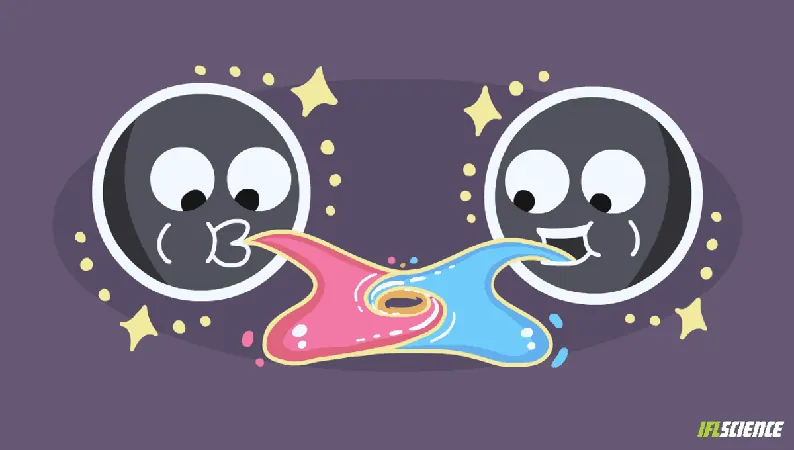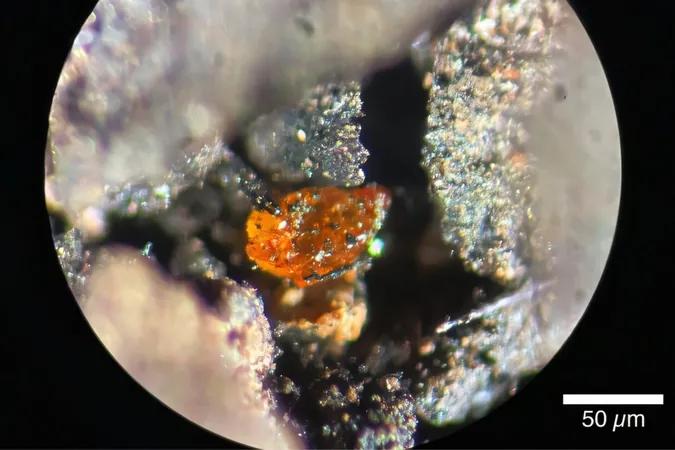
Astronomers Discover Rare Cosmic Feast: Two Supermassive Black Holes Share a Meal!
2024-11-15
Author: Nur
Two Supermassive Black Holes in 2MASX J21240027+340911
In an astonishing revelation from the heart of galaxy 2MASX J21240027+340911, astronomers have uncovered an extraordinary phenomenon: two supermassive black holes are not only residing in the core but are actively sharing a meal, marking the first time such an event has been documented.
A Decade of Observation
For over a decade, this galaxy has been recognized for its active nucleus, where one black hole was previously thought to be feeding on surrounding interstellar material like gas or dust that ventured too close. However, recent observations have illuminated a more complex reality—both black holes, boasting a staggering combined mass of 40 million times that of our Sun, are merely a light-day apart from each other, translating to an immense distance of roughly 26 billion kilometers (16 billion miles). In a cosmic episode that seems straight out of science fiction, these colossal entities are set on a collision course, expected to merge in about 70,000 years. They orbit one another every 130 days, their gravitational dance producing a peculiar repeating signal detected by scientists.
A Recurring Cosmic Event
Lead author Lorena Hernández-García, an astrophysicist at the Millennium Institute of Astrophysics and University of Valparaíso in Chile, described this phenomenon, referred to as AT 2021hdr, as "a very weird event that keeps recurring every few months." She theorizes that a gas cloud has now enveloped the black holes, and as they circle each other, their interaction with this cloud leads to the consumption of its gas, resulting in oscillating light patterns that we observe.
Discovery and Follow-Up Observations
The initial discovery was made by the Caltech-led Zwicky Transient Facility (ZTF) at the Palomar Observatory, which continued to track this unusual occurrence every 60 to 90 days. NASA’s Swift telescope later provided crucial follow-up insights, enhancing our understanding of this cosmic spectacle.
Revising Theories
Initially thought to be a supernova, the recurring bursts in 2022 prompted researchers to reconsider various hypotheses. Co-author Alejandra Muñoz-Arancibia from the same institutions expressed how each subsequent event has refined their model. Among the theories considered were several common behaviors in active galactic nuclei, and the possibility of a star being torn apart by gravitational forces as it approached one of the black holes. However, the dual black hole scenario surrounded by a gas cloud has emerged as the most captivating explanation.
Future Monitoring and Insights
The research team plans extensive future monitoring of this cosmic event, hoping to gain deeper insights into the dynamics at play. Additionally, they are investigating the host galaxy itself, which is currently experiencing a merger. Remarkably, this entire spectacle unfolds at a staggering distance of 1 billion light-years from Earth.
Conclusion
As scientists continue to unveil the mysteries of our universe, this discovery not only enriches our understanding of black hole interactions but also highlights the ongoing chaos and drama unfolding in the far reaches of space. Stay tuned as we uncover more about this breathtaking cosmic feast and what it means for our understanding of black holes!



 Brasil (PT)
Brasil (PT)
 Canada (EN)
Canada (EN)
 Chile (ES)
Chile (ES)
 España (ES)
España (ES)
 France (FR)
France (FR)
 Hong Kong (EN)
Hong Kong (EN)
 Italia (IT)
Italia (IT)
 日本 (JA)
日本 (JA)
 Magyarország (HU)
Magyarország (HU)
 Norge (NO)
Norge (NO)
 Polska (PL)
Polska (PL)
 Schweiz (DE)
Schweiz (DE)
 Singapore (EN)
Singapore (EN)
 Sverige (SV)
Sverige (SV)
 Suomi (FI)
Suomi (FI)
 Türkiye (TR)
Türkiye (TR)